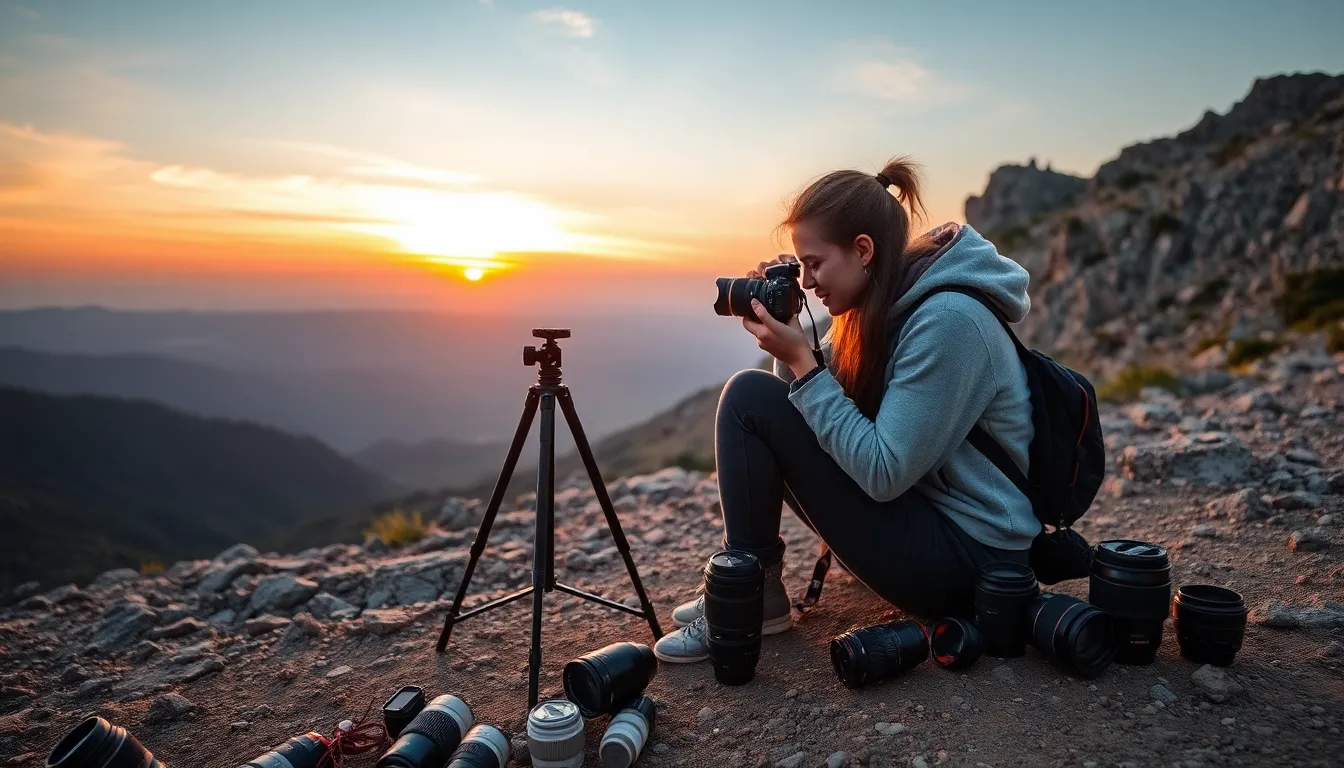Table of Contents
ToggleIn the world of photography, having the right equipment can make the difference between a snapshot and a masterpiece. Whether you’re an aspiring photographer or a seasoned pro, the gear you choose can elevate your work to new heights. Imagine capturing that perfect sunset or a candid moment with friends, all thanks to the magic of a well-chosen lens or a sturdy tripod.
Overview of Photography Equipment
Photography equipment encompasses various tools essential for capturing high-quality images. Cameras form the backbone of this equipment. DSLR cameras, mirrorless cameras, and smartphone cameras each offer unique benefits, allowing photographers to choose based on their style and setting.
Lenses play a vital role in determining image quality and aesthetics. Prime lenses provide sharp images and wider apertures, while zoom lenses offer versatility in framing shots without changing lenses. Specific focal lengths create different perspectives, making the choice of lens crucial for desired outcomes.
Tripods stabilize cameras for long exposures and reduce camera shake. Choosing a lightweight tripod improves portability, while a sturdy one ensures safety on uneven surfaces. Solid construction helps maintain stability during challenging shooting conditions.
Lighting equipment enhances image quality through controlled illumination. Natural light, studio lights, and flash units each create distinct moods. Using reflectors can manipulate light and eliminate harsh shadows, improving overall composition.
Accessories such as memory cards, filters, and camera bags contribute to a photographer’s workflow. High-capacity memory cards support extensive shooting sessions, while filters can adjust colors and reduce glare. Proper storage bags protect equipment during transit.
Other tools include remote shutter releases, which prevent camera shake during long exposures, and lens cleaning kits that maintain clarity. Investing in quality equipment can significantly impact the shooting experience. Regularly assessing needs and exploring new technologies helps photographers stay at the forefront of their craft.
Types of Photography Equipment

Photography relies on various equipment types, each serving a specific purpose. Understanding these categories helps photographers choose the right tools for their needs.
Cameras
Cameras form the foundation of photography. DSLR cameras offer interchangeable lenses and superior image quality, ideal for various photography styles. Mirrorless cameras provide a compact alternative with similar versatility, often favored by travel photographers. Smartphone cameras include advanced technology, making them convenient for casual photography. Each camera type provides unique features that cater to distinct photographic environments.
Lenses
Lenses significantly influence image quality. Prime lenses excel in sharpness and lower light conditions due to wider apertures, suitable for portrait and street photography. Zoom lenses offer flexibility, enabling photographers to adjust focal lengths quickly. Specialty lenses, like macro or fisheye, allow for creative expression in specific scenarios. Selecting the right lens enhances capability and achieves desired artistic effects.
Tripods and Stabilizers
Tripods and stabilizers maintain camera stability during shooting. Sturdy tripods support long exposures and low-light conditions, ensuring sharp images. Lightweight tripods cater to outdoor photographers who prioritize portability. Gimbals and stabilizers provide smooth movement for video shoots, balancing the camera effectively. Utilizing these tools can elevate image quality and expand creative possibilities in various settings.
Important Accessories
Accessories play a vital role in ensuring photographers achieve their desired results. Selecting the right tools enhances the overall photography experience.
Lighting Equipment
Lighting equipment significantly affects image quality. Natural light is often ideal, but using studio lights or flash units allows for control over brightness and shadows. Softboxes diffuse light, creating softer shadows, while reflectors channel light to enhance subject illumination. Portable speedlights provide versatility for on-the-go shooting. Continuous lights help visualize the final image and are useful for video work. Each lighting type contributes uniquely, allowing photographers to shape the mood and style of their photographs.
Memory Cards
Memory cards are essential for storing captured images. SD cards offer various storage capacities, with 64GB to 256GB options commonly favored by photographers. High-speed UHS-II cards ensure faster data transfer, perfect for burst shooting and high-resolution video. Reliability remains paramount; using trusted brands minimizes the risk of data loss during a shoot. Carrying multiple cards provides flexibility, allowing photographers to switch when running low on storage. Regularly formatting cards after backing up images helps maintain optimal performance.
Camera Bags
Camera bags provide necessary protection and organization for gear. Selecting a bag depends on the equipment carried and the shooting style. Backpack-style bags ensure comfortable transport, particularly for long outdoor sessions, while messenger bags offer quick access to gear. Incorporating padded dividers keeps each component secure and prevents damage during transit. Waterproof or weather-resistant materials safeguard equipment from the elements, permitting shoots in varying conditions. Choosing the right bag enhances convenience, ultimately keeping photographers focused on capturing images.
Choosing the Right Equipment
Selecting the right photography equipment aligns with individual goals and preferences. Prioritizing personal style influences decisions around gear.
Consider Your Photography Style
Understanding photography style guides choices in equipment. Portrait photographers should prioritize prime lenses for sharpness and low-light performance. Landscape photographers benefit from wide-angle lenses and sturdy tripods for stability. Action photographers require fast-focusing cameras with zoom lenses for flexibility in capturing moving subjects. Identifying these elements enhances a photographer’s ability to express their vision effectively.
Budget Considerations
Establishing a budget determines the type and quality of equipment. Allocating funds for essential items, such as cameras and lenses, remains crucial. High-quality gear often provides better image quality and longevity, making it a worthwhile investment. Purchasing at the right time, like during sales or discounts, maximizes value. Prioritizing must-have accessories, including memory cards and bags, ensures comprehensive protection and functionality within budget constraints.
The right photography equipment is a game changer for anyone looking to elevate their craft. By understanding the unique benefits of various cameras and lenses photographers can make informed choices that align with their specific styles and goals. Whether it’s capturing the perfect sunset or a fleeting candid moment the right gear enhances both the experience and the results.
Investing in quality equipment not only improves image quality but also fosters creativity and confidence. As photographers continually assess their needs and adapt their gear accordingly they unlock new possibilities in their artistic journey. Ultimately the right tools empower them to turn their visions into stunning realities.






